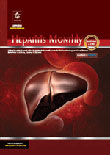فهرست مطالب

Hepatitis Monthly
Volume:15 Issue: 8, Aug 2015
- تاریخ انتشار: 1394/06/30
- تعداد عناوین: 6
-
-
Page 2IntroductionGastrointestinal basidiobolomycosis is an emerging infection, with fewer than 80 cases reported in the English literature..Case PresentationAlso, a few cases of gastrointestinal basidiobolomycosis, accompanied by liver involvement as part of a disseminated disease, have been reported..ConclusionsThis is the first case report of an isolated liver involvement of this fungal infection in a 2-year-old girl, who presented with a liver mass resembling a hepatic abscess..Keywords: Liver, Basidiobolomycosis, Immunocompetent
-
Page 3BackgroundsSerum hepatitis B surface antigen (HBsAg) levels are associated with fibrosis in patients with chronic hepatitis B (CHB) infection..ObjectivesThe aim of our study was to evaluate serum HBsAg level as a biomarker for compensated cirrhosis in hepatitis B e antigen (HBeAg) positive CHB patients..Patients andMethodsTwo-hundred and one HBeAg-positive Chinese CHB patients with or without cirrhosis were enrolled in this retrospective study. Cirrhosis was diagnosed based on liver biopsy. Furthermore, patients with decompensated cirrhosis were excluded. A statistical analysis was performed regarding the association between serum HBsAg level and compensated cirrhosis..ResultsPatients with compensated cirrhosis had a significantly lower mean serum HBsAg level compared to those without cirrhosis (3.27 Log10 IU/mL VS 4.17 Log10 IU/mL, P < 0.001). Furthermore, examining the correlation with compensated cirrhosis revealed that lower level of serum HBsAg was a significant factor in multivariate analysis. The area under the receiver operating characteristics curve of serum HBsAg was 0.856 for compensated cirrhosis. A positive predictive value of 66.2% and negative predictive value of 90.7% were obtained with a cut-off value of < 3.60 Log10 IU/mL (4000 IU/mL) of serum HBsAg. Moreover, the rate of compensated cirrhosis increased to 75.0% after combining with APRI > 2..ConclusionsIn HBeAg positive CHB patients, low serum HBsAg level is a useful predictor of compensated cirrhosis..Keywords: Hepatitis B Surface Antigens_Liver Cirrhosis_Hepatitis B e Antigens_Hepatitis B_Chronic
-
Page 5BackgroundMacrophages play critical roles in innate immune response in the liver. Whether macrophages participate in liver innate immunity against HCV replication is poorly understood.ObjectivesThe aim of this study was to investigate the role of macrophages in liver innate immunity against HCV replication..Materials And MethodsFreshly isolated monocytes were purified from peripheral blood of healthy adult donors. Macrophages refer to 7-day-cultured monocytes in vitro. A hepatoma cell line (Huh7) was infected with HCV JFH-1 to generate in vitro HCV infectious system. RT-PCR was used to determine HCV RNA and mRNA levels of genes expression. ELISA was used to measure the protein level of interferon-α (IFN-α) and western blot was used to determine protein expression level of Toll-like receptor 3 (TLR3)..ResultsHCV dsRNA induced the expression of type I IFN (IFN-α/β) in monocyte-derived macrophages. HCV dsRNA also induced the expression of TLR3 and IFN regulatory factor-7 (IRF-7), the key regulators of the IFN signaling pathway. When HCV JFH-1-infected Huh7 cells were co-cultured with macrophages activated with HCV dsRNA or incubated in media conditioned with supernatant (SN) from HCV dsRNA-activated macrophages, HCV replication was significantly suppressed. This macrophage SN action on HCV inhibition was mediated through type I IFN, which was evidenced by the observation that antibody to type I IFN receptor could neutralize the macrophages-mediated anti-HCV effect. The role of type I IFN in macrophages-mediated anti-HCV activity is further supported by the observation that HCV dsRNA-activated macrophages SN treatment induced the expression of several IFN-stimulated genes (ISGs), ISG15, ISG56, OAS-1, OAS-2, MxA and Viperin in HCV-infected Huh7 cells..ConclusionsMacrophages may play an important role in liver innate immunity against HCV replication through a type I IFN-dependent mechanism..Keywords: Hepatitis C Virus_Interferon_Macrophages_Toll_Like Receptor 3
-
Page 6BackgroundViral load measurements are commonly used to monitor HCV infection in patients with chronic diseases or determining the number of HCV-genomes in serum samples of patients after sustained virological response. However, in some patients, HCV viral load in serum samples is too low to be detected by PCR, especially after treatment..ObjectivesThe aim of this study was to develop a highly specific, sensitive, and reproducible in-house quantitative PCR using specific primers and probe cited in highly conservative region of HCV genome that allows simultaneous detection of HCV genotypes 1 - 4..Materials And MethodsIn this study, three sets of primer pairs and a TaqMan probe for amplification and detection of selected region within 5’-non-coding (5’NCR) of four HCV genotypes were used. Using plasmid containing 5’NCR region of HCV, standard curve, threshold, and threshold cycle (CT) values were determined. Real-time and nested PCR were performed on HCV genotypes 1 - 4 extracted from plasma and peripheral blood mononuclear cells (PBMCs) samples collected from patients with chronic HCV infection..ResultsThe lower limit detection of this in-house HCV real-time RT-PCR was determined as 100 RNA copies/mL. Inter- and intra-assay coefficient of variation (CV) of this in-house HCV real-time RT-PCR ranged from 0.9% to 1.8% and 1.76% to 3.94%, respectively. The viral load of the genotyped samples ranged from 2.0 × 106 ± 0.31 to 2.7 × 105 ± 0.46 copies/mL in serum samples and 5 × 102 ± 0.36 to 4.0 × 103 ± 0.51 copies/106 cells/mL of PBMCs..ConclusionsThe quite sensitive in-house TaqMan real time RT-PCR assay was able to detect and quantify all four main HCV genotypes prevailing around all geographical regions of Iran..Keywords: Hepatitis C Virus_Mononuclear Leukocytes_Real_Time Polymerase Chain Reaction

